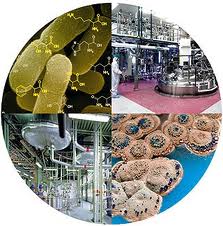
1977:
The Age of biotechnology arrives with somatostatin - a human growth hormone-releasing inhibitory factor the first human protein manufactured in bacteria by Genentech, Inc.
A synthetic recombinant gene was applied to clone a protein for the very first time.
1978:
Genentech Inc. plus the City of Hope National Medical Center announce the successful laboratory production of human insulin utilizing recombinant DNA technology.
Hutchinson and Edgell show it truly is probable to introduce distinct mutations at certain web-sites in a DNA molecule.
1979:
Sir Walter Bodmer suggests a way of working with DNA technologies to discover gene markers to show up particular genetic diseases and their carriers.
John Baxter reports cloning the gene for human growth hormone.
1980:
The prokaryote model, E. coli is utilised to generate insulin along with other medicine in human form.
Researchers successfully introduce a human gene - 1 that codes for the protein interferon- into a bacterium.
The U.S. patent for gene cloning is awarded to Cohen and Boyer.
1981:
Scientists at Ohio University generate the very first transgenic animals by transferring genes from other animals into mice.
The very first gene-synthesizing machines are developed.
Chinese scientists successfully clone a golden carp fish.
1982:
Genentech, Inc. receives approval from the Food and Drug Administration to market genetically engineered human insulin.
Applied Biosystems Inc. introduces the first commercial gas phase protein sequencer.
1983:
The polymerase chain reaction is invented by Kary B Mullis.
The first artificial chromosome is synthesized and the very first genetic markers for particular inherited illnesses are found.
1984:
Chiron Corp. announces the first cloning and sequencing of the entire human immunodeficiency virus (HIV) genome.
Alec Jeffreys introduces method for DNA fingerprinting to identify individuals.
The very first genetically engineered vaccine is developed.
1985:
Cetus Corporation's develops GeneAmp polymerase chain reaction (PCR) technologies which could generate billions of copies of a targeted gene sequence in only hours.
Scientists locate a gene marker for cystic fibrosis on chromosome quantity 7.
1986:
The first genetically engineered human vaccine - Chiron's Recombivax HB - is approved for the prevention of hepatitis B.
A regiment of scientists and technicians at Caltech and Applied Biosystems, Inc. invented the automated DNA fluorescence sequencer.
1987:
The first outdoor tests on a genetically engineered bacterium are allowed.
It inhibits frost formation on plants.
Genentech's tissue plasminogen activator (tPA), sold as Activase, is approved as a treatment for heart attacks.
1988:
Harvard molecular geneticists Philip Leder and Timothy Stewart awarded the first patent for a genetically altered animal a mouse which is extremely susceptible to breast cancer
1989:
UC Davis scientists develop a recombinant vaccine against the deadly rinderpest virus.
The human genome project is set up a collaboration between scientists from countries all over the world to function out the entire of the human genetic code.
1990:
The first gene therapy takes location, on a four-year-old girl with an immune-system disorder called ADA deficiency. The human genome project is formally launched.
1991:
Mary-Claire King of the University of California Berkeley finds evidence that a gene on chromosome 17 causes the inherited type of breast cancer and also increases the risk of ovarian cancer.
Tracey the first transgenic sheep is born.
1992:
The very first liver xenotransplant from 1 sort of animal to yet another is carried out successfully.
Chiron's Proleukin is approved for the treatment of renal cell cancer.
1993:
The FDA declares that genetically engineered foods are "not inherently dangerous" and do not need unique regulation.
Chiron's Betaseron is approved as the very first treatment for many sclerosis in 20 years.
1994:
The first genetically engineered food item the Flavr Savr tomato gained FDA approval.
The first breast cancer gene is discovered. Genentech's Nutropin is approved for the treatment of growth hormone deficiency.
1995:
Researchers at Duke University Medical Center transplanted hearts from genetically altered pigs into baboons proving that cross-species operations are achievable.
The bacterium Haemophilus influenzae is the first living organism in the globe to have its whole genome sequenced.
1996:
Biogen's Avonex is approved for the treatment of multiple sclerosis.
The discovery of a gene associated with Parkinson's illness gives an significant new avenue of study into the trigger and possible treatment of the debilitating neurological ailment.
1997:
Researchers at Scotland's Roslin Institute report that they've cloned a sheep--named Dolly--from the cell of an adult ewe.
The FDA approves Rituxan the very first antibody-based therapy for cancer.
1998:
The first total animal genome the C.elegans worm is sequenced.
James Thomson at Wisconsin and John Gearhart in Baltimore every develop a method for culturing embryonic stem cells.
1999:
A new medical diagnostic test will for the first time allow fast identification of BSE/CJD a rare but devastating type of neurologic disease transmitted from cattle to humans.
2000:
"Golden Rice," modified to make vitamin A. Cloned pigs are born for the first time in function done by Alan Coleman and his team at PPL, the Edinburgh-based firm responsible for Dolly the sheep.
2001:
The sequence of the human genome is published in Science and Nature, creating it probable for researchers all over the world to begin creating genetically based treatments for illness.
2002:
Researchers sequence the DNA of rice, and is the initial crop to have its genome decoded.
2003:
The sequencing of the human genome is completed.
 RSS Feed
RSS Feed